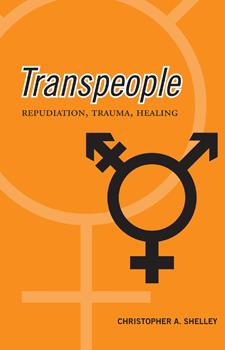
Credit: University of Toronto Press
Nearly 10 years ago, now UBC professor Chris Shelley was “chided” by two fellow activists for engaging with the experiences of transpeople.
“[They] told me flat out that there was no such thing as transsexuals, that these were just disturbed queer people,” he says. They also labeled his project “antifeminist.”
Though Shelley believes that most feminists today are supportive of trans struggles, several transpeople he interviewed told of contentious encounters with radical cultural feminists.
He says that in the eyes of some radical cultural feminists, those who have not had “the history of living as a girl or a woman,” cannot claim to identify as women.
Kimberly Nixon’s unsuccessful 12-year legal battle against Vancouver Rape Relief for excluding her on the basis of her transsexuality is a high-profile example of the social and political tensions that can arise over gender identity and expression.
The case went all the way to the Supreme Court of Canada, which refused to hear it. That decision ensured that the BC Court of Appeals 2005 ruling, upholding Rape Relief’s right to choose its own members and decide who counts as a woman for its own purposes, stood.
Shelley’s new work Transpeople: Repudiation, Trauma, Healing, which grew out of his doctoral thesis, delves into the social, political and academic sources of trans repudiation, which he posits is transphobia, but more than just phobia. The author, along with those who contributed their personal narratives, takes a look at the complexities of trans experiences and provides ways of “talking back” to marginalizing forces.
Through in-depth interviews with 20 subjects who self-identify as two-spirit and/or transsexual (TS) or transgender (TG), Shelley identified nine broad arenas in which transpeople encounter repudiation, including health care and employment, and through threats and violence.
Shelley’s interviewees are quoted at length throughout. “In this book,” he writes, “transpeople are assumed to be the primary experts on their own lives.”
“I intentionally looked for a range of voices so that a lot of different perspectives within trans could be heard,” he says.
He also contends that the field of psychoanalytics needs to shift from “solving” trans identities to grappling with the roots of anti-trans attitudes.
“I suggest that the project of trying to clinically understand transpeople be abandoned,” he writes. “Rather, some core psychoanalytic concepts can be re-harnessed in an attempt to understand the perpetrators of trans repudiation.”
“If transpeople disrupt our fixed sense of the order of things, this may actually be perceived and received as a positive event,” Shelley writes. “Transpeople have something profound to teach us, yet unless we take down our defenses we may not hear them.”
Shelley argues that our social perception of gender is constituted of fictions within fictions. “gender is never achievable but always pursued,” he writes. “We are gendered as if there were such a thing as gender.”
Following such theorists as Judith Butler and Sara Ahmed, Shelley differentiates “sex” (a biological category based on conclusions about genitalia and chromosomes) from the ever-changing standards of “opposite” gender categories that include “traditional” roles, stereotypes, and other such expectations of femininity and masculinity.
But even while applying these complex ideas to the lived experiences of transpeople, Shelley says his aim is not to sidestep disagreement, tension and conflict that exists among transpeople themselves.
The decision about whether to undergo sexual reassignment surgery or not is one obvious area of disagreement and tension.
For his part, Shelley believes at present that TS-identified people need a clear-cut division between two genders in order to access publicly funded sex reassignment surgeries. The clinical argument for this medical intervention is that gender conformity is a “marker of sanity,” he says, and that the body must be made to conform if the mind cannot.
Anxiety about being “caught” in what others might deem the “wrong” space and the threat of anti-trans violence, also inform the decision to undergo such procedures and to better “pass,” according to Shelley.
One of his interviewees puts it simply: “Transpeople get targeted when we’re visible,” he says. “Period.”
But while some transpeople want to simply disappear into the binary, Shelley notes, “others want to overthrow it.”
Some TG activists, he explains, believe that the idea of passing runs counter to their goal of a social rejection of gender roles. Paradoxically, TG-identified people are often forced to conform to the very binary from which TS individuals are alienated, he says.
Still others identify as cultural outsiders to the Western conceptualization of binary genders and reject it altogether.
Transpeople confront this debate, between those who believe that gender is in-born, whether or not the body is mis-sexed, and those who argue that it is a constructed concept.
Over the course of his research, Shelley admits that it was “sad” for him to deal with the fact that lesbians and gays themselves were often the source of nasty commentary and actions against transpeople.
“Transpeople have always been within LGB, and now, TQ communities,” says Shelley. “They’ve been there from Stonewall, they’ve been there from before Stonewall,” he emphasizes, but they “keep getting overlooked.”
Interviewees explain how some lesbians and gays have misunderstood or repudiated them, by perceiving transmen as “traitors” to women or to lesbianism, or transwomen as threats to a tenuous gay masculinity, for example.
In the book’s conclusion, Shelley emphasizes the role of allies and says that without them, “the whole burden of social change would rest solely with transpeople.” He points to the debate over lavatory designations that’s happening on numerous college and university campuses across the continent as an encouraging example of the supportive role allies have played when they’ve reached out to trans communities.
Shelley hopes more queer allies will take up the work needed “to legitimately put the T on LGB”.

 Why you can trust Xtra
Why you can trust Xtra


